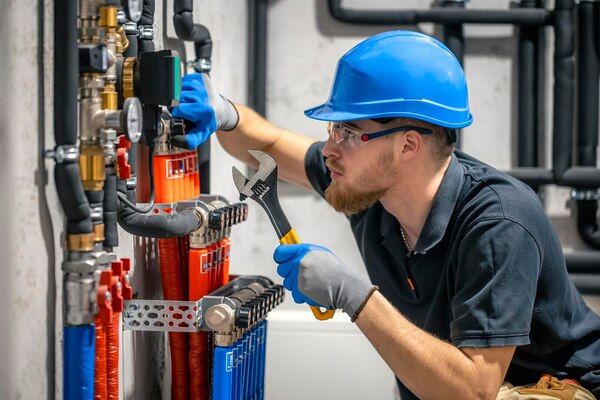Notifications
ALL BUSINESS
COMIDA
DIRECTORIES
ENTERTAINMENT
FINER THINGS
HEALTH
MARKETPLACE
MEMBER's ONLY
MONEY MATTER$
MOTIVATIONAL
NEWS & WEATHER
TECHNOLOGIA
TV NETWORKS
VIDEOS
VOTE USA 2026/2028
INVESTOR RELATIONS
DEV FOR 2025 / 2026
ALL BUSINESS
COMIDA
DIRECTORIES
ENTERTAINMENT
FINER THINGS
HEALTH
MARKETPLACE
MEMBER's ONLY
MONEY MATTER$
MOTIVATIONAL
NEWS & WEATHER
TECHNOLOGIA
TV NETWORKS
VIDEOS
VOTE USA 2026/2028
INVESTOR RELATIONS
DEV FOR 2025 / 2026
About Me
 DrainCom Inc.
DrainCom Inc. DrainCom Inc. is a trusted name in plumbing, drain services, and waterproofing, providing top-quality solutions to homeowners and businesses.
Posted by - DrainCom Inc. -
on - 6 hours ago -
Filed in - Other -
21 Views - 0 Comments - 0 Likes - 0 Reviews

Have you ever experienced water in your basement? If so, a sump pump installation would be the most effective solution to get rid of water intrusion issues. A sump pump is designed to remove excess water from your basement, preventing flooding and keeping your home dry. However, when it comes to choosing a sump pump, careful consideration is necessary to prevent selecting the wrong one. In this article, let's understand some key factors to help you choose the right sump pump for your home's basement. So, let's get started!
Go Through the Different Sump Pump Types
Suppose you're considering purchasing a sump pump but are unfamiliar with its various types. How will you make the right purchase? And what if you select a type that's not compatible with your basement needs? You'll just waste your money and invite more water damage problems to your basement. That's why you first understand the different types of sump pumps. Look at the most common types:
Pedestal Sump Pumps: Pedestal sump pumps are operated by a motor mounted above the sump basin on a long pedestal. These are easy to maintain and repair because the motor is accessible above the water. However, there are two drawbacks: these pumps generate excessive noise and may not be as effective for large areas. Consider the environment and location where you'll install this sump pump.
Submersible Sump Pump: Submersible sump pumps are installed below the water level in the sump basin. These pumps are typically quieter than pedestal pumps and offer greater effectiveness in water pumping.
Water-Powered Sump Pump: These pumps are operated by water pressure rather than batteries or electricity, allowing you to use them even when power is cut. While they have a strong benefit, they also have drawbacks. They tend to be less potent than electric pumps and are best for homes with a reliable water supply.
Battery-Backup Sump Pump: If you live in an area prone to frequent power outages, opt for a battery backup sump pump installation..
Pump Capacity
Another factor to consider is the sump pump's capacity to move water away from the basement. Most residential sump pumps are available in 1/4 horsepower, 1/3 horsepower, and 1/2 horsepower sizes.
If your basement is small and has minimal exposure to water, a 1/4 horsepower sump pump may be the best option.
For the average-sized basement, a sump pump with 1/3 horsepower would be a good choice.
For larger homes or basements with higher water levels, a sump pump with 1/2 horsepower might be beneficial.
Float Switch
A float switch triggers the sump pump to operate when water reaches a predetermined level. Always choose a pump with a high-quality float switch, as this will ensure your pump operates when you need it most. There are different types of float switches, such as:
Vertical Float Switch: This type of float switch moves vertically and can be more reliable.
Diaphragm Switch: These are pressure-activated switches that don't require floats. They are more durable and expensive.
Tethered Float Switch: This type of float switch is attached to the pump by a cord and floats up with the water level to activate the pump. However, if there's not enough room for them to move freely, they can sometimes get stuck in the pit.
Material and Durability
When selecting a sump pump, consider the type of material it is made from. Stainless steel, cast iron, or plastic, all these materials are used in designing sump pumps and can significantly impact their durability. Cast iron is very durable and long-lasting, capable of handling high-volume pumping. Stainless steel is also durable, offering added benefits such as resistance to rust and corrosion. Besides these materials, plastic is a wise choice for those seeking a lighter and more affordable solution to water intrusion. However, this may not last as long as cast iron and stainless steel models.
Additional Features
Well-designed sump pumps come with additional features, such as an alarm system (in case the pump fails to activate or does not function properly, an alarm will notify you), corrosion-resistant parts (pumps that resist corrosion last longer), automatic on/off capabilities, and easy maintenance. Consider choosing a sump pump with these features for enhanced effectiveness.
Cost
Sump pumps vary in price range. The cost will depend on the type of pump, its capacity, durability, and any additional features. You may not prefer choosing an expensive model, but remember that investing in a reliable and appropriately sized pump can save you significant money and headaches in the long run by preventing costly water damage.
To sum up, a sump pump installation is the most effective way that not only saves your basement from water damage but also enhances your home's property value. Choosing the right sump pump is not overwhelming if you carefully consider the above-mentioned factors. So, take some time and thoroughly assess your needs for your basement before purchasing.